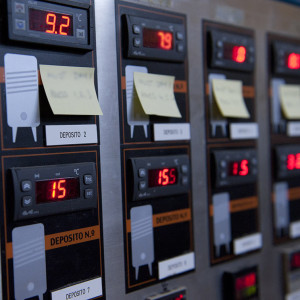Temperature control
October 21st, 2014 | Winemaking
 Firstly my apologies for the silence over the last few days….. we have been a bit busy. All the additions have finally been made to the fermenting tanks and so the only thing left to do is wait. Of course, it goes without saying that we have to monitor the progress of each and every tank, and sometimes make small adjustments to the temperature if things are not progressing as we wish. This is exactly what we mean by ‘temperature control’ – we can adjust the speed of the fermentation simply by altering the temperature. Fermentation generates heat, and if left unchecked would career out of control and the whole fermentation process would probably be over in less than a week….. but the resulting wine? Well, perhaps not so good.
Firstly my apologies for the silence over the last few days….. we have been a bit busy. All the additions have finally been made to the fermenting tanks and so the only thing left to do is wait. Of course, it goes without saying that we have to monitor the progress of each and every tank, and sometimes make small adjustments to the temperature if things are not progressing as we wish. This is exactly what we mean by ‘temperature control’ – we can adjust the speed of the fermentation simply by altering the temperature. Fermentation generates heat, and if left unchecked would career out of control and the whole fermentation process would probably be over in less than a week….. but the resulting wine? Well, perhaps not so good.
By monitoring the density twice a day, we can accurately measure how quickly the must is being converted into wine, and if we see that it is moving too quickly then we can simply reduce the tank temperature by half or maybe one degree, and this will bring the process back under control. Of course the speed at which we chose to make the fermentation is down to the individual winemaker, and relies both on experience, but also has to take into account the type of yeast being used. Different strains of yeast behave in very different ways, some are far more vigorous than others, and in addition they will often work within a completely different temperature range. For example, making the temperature too cold might simply kill some strains of yeast, leaving a partly fermented wine. In addition, towards the end of the fermentation, we have to raise the temperature of the tanks slightly to allow the yeast to fully ferment and complete it’s job. Stopping the fermentation too early will simply result in a little more residual sugar being left in the finished wine – not a typical characteristic of albariño. Having said that, anything less than 5 grams of sugar per litre of wine will be barely discernable to the average consumer.
 Firstly my apologies for the silence over the last few days….. we have been a bit busy. All the additions have finally been made to the fermenting tanks and so the only thing left to do is wait. Of course, it goes without saying that we have to monitor the progress of each and every tank, and sometimes make small adjustments to the temperature if things are not progressing as we wish. This is exactly what we mean by ‘temperature control’ – we can adjust the speed of the fermentation simply by altering the temperature. Fermentation generates heat, and if left unchecked would career out of control and the whole fermentation process would probably be over in less than a week….. but the resulting wine? Well, perhaps not so good.
Firstly my apologies for the silence over the last few days….. we have been a bit busy. All the additions have finally been made to the fermenting tanks and so the only thing left to do is wait. Of course, it goes without saying that we have to monitor the progress of each and every tank, and sometimes make small adjustments to the temperature if things are not progressing as we wish. This is exactly what we mean by ‘temperature control’ – we can adjust the speed of the fermentation simply by altering the temperature. Fermentation generates heat, and if left unchecked would career out of control and the whole fermentation process would probably be over in less than a week….. but the resulting wine? Well, perhaps not so good.
By monitoring the density twice a day, we can accurately measure how quickly the must is being converted into wine, and if we see that it is moving too quickly then we can simply reduce the tank temperature by half or maybe one degree, and this will bring the process back under control. Of course the speed at which we chose to make the fermentation is down to the individual winemaker, and relies both on experience, but also has to take into account the type of yeast being used. Different strains of yeast behave in very different ways, some are far more vigorous than others, and in addition they will often work within a completely different temperature range. For example, making the temperature too cold might simply kill some strains of yeast, leaving a partly fermented wine. In addition, towards the end of the fermentation, we have to raise the temperature of the tanks slightly to allow the yeast to fully ferment and complete it’s job. Stopping the fermentation too early will simply result in a little more residual sugar being left in the finished wine – not a typical characteristic of albariño. Having said that, anything less than 5 grams of sugar per litre of wine will be barely discernable to the average consumer.


